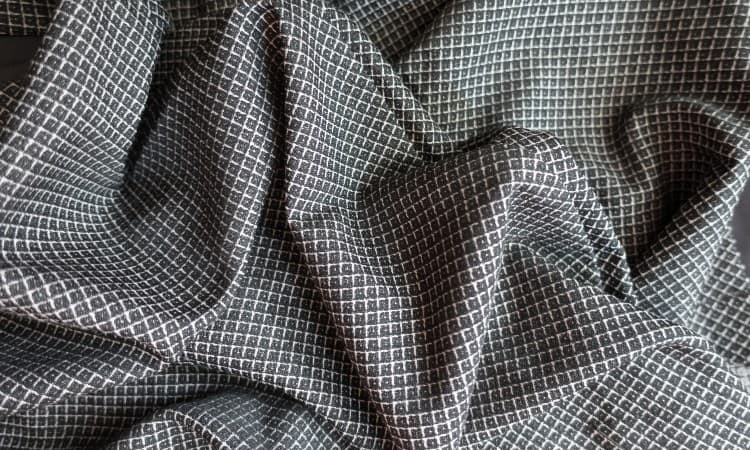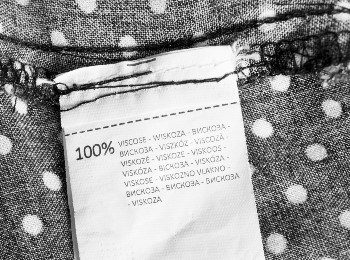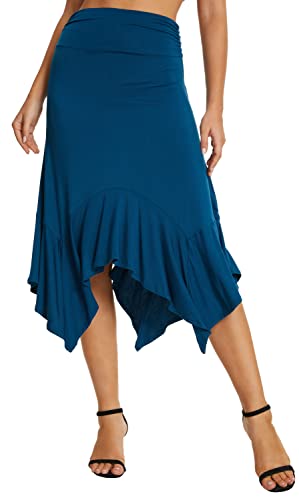Have you ever bought a dress that felt just a smidge too small and figured it would stretch out over time? This works for some kinds of fabric, but not all! If you’re shopping for summer clothes like silky shirts and dresses, you may find yourself wondering, is viscose stretchy?
Viscose fibers do not stretch on their own, though knitted viscose or a viscose blend may have some stretch. Viscose is a semi-synthetic material made from chemically processed tree pulp. It has many popular uses as a silk substitute, including in dresses, skirts, and blouses.
In this article, you will find out where viscose comes from. You will also learn what makes it stretch. Finally, you will discover some tips for taking care of your viscose clothing!

What Is Viscose and How is It Made?
Viscose is a semi-synthetic fabric made from wood pulp that looks and feels like silk. First invented in the late 1800s as a cheap alternative to real silk, this synthetic silk drapes well and has an appealing sheen.
Viscose often has a lightweight weave. It feels soft like cotton and breathes quite well. All of these characteristics make it popular for summer clothing!
Though viscose does not have a body-hugging elasticity like some fabric types, it drapes in a flowing, elegant way. It also holds a shape like a pleat or curved seam quite well, making it popular for skirts and dresses.
On the downside, producing this material requires many dangerous chemicals, making it an environmentally unfriendly kind of fabric. Viscose is a type of rayon, but it uses more dangerous chemicals than some other types of rayon. These include carbon disulfide and sodium hydroxide.

So, what creates a semi-synthetic fabric? Well, a fully synthetic material contains 100% man-made fibers. Semi-synthetic fabric, in contrast, originates as a natural product that is chemically altered.
Viscose comes from the wood pulp of beech or pine trees, though some types may contain bamboo pulp instead. This pulp then goes through a complex production process that changes the chemical make-up of the wood, creating something different!
First, a massive amount of wood chips get dissolved by a storm chemical, usually sodium hydroxide.
Next, the wood-chip-mash goes through a washing and bleaching process.
The pulp then goes through two more treatments. A soak in carbon disulfide turns the wood pulp into a sort of chemical soup. Finally, a rinse in more sodium hydroxide creates the final viscose solution.
At this point, factory machines called spinnerets extrude the viscose solution into filaments. Another set of machines twist these filaments into yarn. Finally, the factory looms to weave the yarns into fabric!
Sometimes manufacturers also dye the yarn before sending them on for the weaving process. Because of its semi-synthetic nature, viscose requires a special dying process that makes it dye-fast. This means that it will not fade over time and no dye will come out in the wash!
Is 100% Viscose Stretchy?
 Viscose fibers do not have any elasticity on their own, but some kinds of viscose fabric may feel stretchy, depending on how the material is made.
Viscose fibers do not have any elasticity on their own, but some kinds of viscose fabric may feel stretchy, depending on how the material is made.
Viscose can stretch for two different reasons. First, knit fabric has some stretch to it because of the interlocking loops structure of the threads. Second, this fabric often contains a blend of fibers, including an elastic material such as spandex.
That said, 100% viscose threads woven in a plain over-under cross-weave will not stretch at all under normal circumstances.
If you’re shopping for viscose blouses or dresses, check the manufacturer’s label inside the garment. This will tell you whether or not the material contains any blended elastic fibers. If it does, the garment will stretch at least a little!
You can also look closely at the threads in the material. If they have a simple over-under weave, the material probably will not stretch. However, if the threads look like a microscopic version of a knitted sweater with many tiny loops interlocking, the material has a knit structure and may stretch a bit!
Most of the time, you should make sure you buy a size that fits you precisely when shopping for viscose clothing. On its own, this material will not soften or stretch out over time to fit your body shape.
How Much Does Viscose Stretch?
 Unless it contains a blend of a stretchier kind of fiber, viscose fabric typically stretches less than 2%. If you have a silky viscose scarf and you hold one end in each hand and tug on it, you will not feel any stretch at all!
Unless it contains a blend of a stretchier kind of fiber, viscose fabric typically stretches less than 2%. If you have a silky viscose scarf and you hold one end in each hand and tug on it, you will not feel any stretch at all!
That said, viscose with a loose weave may expand or contract when exposed to moisture. Knit viscose also has more stretch capacity than woven viscose.
In the fashion world, viscose features most often in lustrous, silky clothing that isn’t necessarily form-fitting. For example, pleated skirts, button-down blouses, and flowing sundresses look really nice made out of viscose!
Does Viscose Stretch When Washed?
Viscose material requires dry cleaning because the material can stretch or stain when washed. The unique chemical nature of its fibers allows them to rapidly absorb moisture, but this process weakens the cloth significantly.
If necessary, you can also hand-wash viscose in cold water without any squeezing, wringing out, or rough tugging. Most of the time, this will not damage the fabric. If possible, find a flat surface to air-dry the garment after washing.
If you want to stretch your viscose clothing, you can carefully soak it and stretch it, following the steps described later in this article!
However, generally speaking, you should follow the instructions on the care label inside the garment. This label will almost always suggest dry cleaning to protect the delicate material.
Does Viscose Stretch With Wear?
 Viscose does not stretch with wear unless it is exposed to a significant amount of moisture. If you wear a viscose shirt when you go jogging every day, it may absorb enough sweat to weaken its fibers, allowing it to stretch.
Viscose does not stretch with wear unless it is exposed to a significant amount of moisture. If you wear a viscose shirt when you go jogging every day, it may absorb enough sweat to weaken its fibers, allowing it to stretch.
That said, if your favorite silky viscose skirt feels a bit tight around the waist, don’t count on it easing to fit you over time! It will not stretch without some type of outside interference.
Of course, if your garment contains a blend of elastane, spandex, or lycra, that’s a different story! These elastic-infused blended types of viscose very likely will stretch out a bit over time, especially if you wear the garment a lot.
Can You Stretch Viscose?
You can stretch viscose by exposing it to moisture or steam. That said, stretching any kind of material is a risky business. You could easily end up with one sleeve longer than the other, a sagging middle of a skirt, or even a crooked dress!
In general, knit viscose (such as a silky cardigan or a t-shirt style shirt) will stretch more easily than a woven rayon garment. If your favorite rayon cardigan shrinks in the wash, you can probably unshrink it by following the steps described in this article.
How to Stretch Viscose
 You can stretch viscose on purpose by soaking it and stretching it by hand or wearing it while wet. You can usually stretch your viscose garment by 3%-5% by using one of these methods, but as you learned earlier, you can’t necessarily count on getting an excellent result.
You can stretch viscose on purpose by soaking it and stretching it by hand or wearing it while wet. You can usually stretch your viscose garment by 3%-5% by using one of these methods, but as you learned earlier, you can’t necessarily count on getting an excellent result.
The risk in all of these methods is that moisture does weaken the fibers in this material, so you may end up damaging the garment while trying to stretch it.
That said, if it’s either stretch it out to fit or throw it away, you have nothing to lose by trying to stretch your viscose clothing! In that case, go ahead and give it a try.
Water
If you accidentally wash a viscose garment and it shrinks, the easiest way to reshape it is to get it wet again!
- First, fill a basin or a clean sink with cool water.
- Submerge the garment in the water and let it soak for five minutes. You do not need to leave it in the water for too long, as additional exposure to moisture will weaken the fibers further.
- Next, lift the wet garment out of the water and lay it flat on a clean bath towel.
- Do not wring the garment out, as this twisting motion could tear the delicate fabric when wet!
- Roll up the towel with the garment inside to press out some of the water.
- Gently stretch out the damp garment. If the sleeves shrunk too short, hold the should and cuff and tug gently but firmly. If the waist shrunk, pull on both sides of the waist.
- Allow the garment to air dry and then try it on to see if you succeeded in stretching it out!
Shampoo or Conditioner
Adding a small amount of baby shampoo or hair conditioner to a water bath can also relax the fibers in viscose fabric, making it easier to stretch.
This method makes it easier to stretch your clothing than just soaking it in water. However, you do run the risk of shampoo or conditioner staining or discoloring the material.
- Measure a quart of cool water into a bowl or a clean sink.
- Measure one tablespoon of baby shampoo or hair conditioner into the water, and mix it up well.
- Submerge the garment and allow it to soak for a couple of minutes. It doesn’t take long!
- Don’t wring out the water after the soak. Just place the wet garment on a clean towel.
- Roll up the towel with the garment inside to press out the excess moisture.
- Carefully stretchy the garment back into size by pulling on it with both hands.
- Allow it to air dry in the new shape.
Steamer or Iron
Using a hand-held steamer offers the quickest method for unshrinking or stretching your viscose clothing. You can also use an iron on a low steamer setting, though you will have to make sure you do not scorch the delicate fabric!
You can iron viscose safely to unwrinkle it, as well as for this special stretching method. You need to turn it inside out and iron the wrong side of the material after spritzing it with clean water. Also, set your iron to the silk setting, or simply select the lowest heat setting available.
To use a handheld steamer:
- Hang up your rayon garment on a plastic hanger. You will need a location near an outlet, with something to hang the garment onto. A shower curtain rod usually works well.
- Fill your steamer with water and heat it until you see steam hissing out of it.
- Hold the steaming nozzle about an inch from the garment and move it slowly up and down so that every part of the garment gets steamed.
- Turn off the steamer and set it aside.
- Stretch the garment out by hand. It should feel warm and slightly damp to the touch.
- If necessary, repeat the steaming process and then stretch again.
To use an iron:
- Turn the garment inside out and arrange it flat on an ironing board.
- Make sure your iron has enough water in it to enable the steam option.
- Set your iron to the silk setting, or choose a low-heat setting.
- Hold the iron close to the fabric’s surface and press the “steam” button to release a puff of steam onto the material. Repeat this till you have steamed one side of the garment.
- Flip the garment over, and do it again.
- Turn off the iron and set it aside.
- Gently stretch the warm and slightly damp garment by hand.
Wear It
Wearing a damp viscose garment to stretch it out may not feel pleasant, but it usually works! If you don’t mind an hour of clammy clothing, give this method a try.
The risk with this technique is that wearing too-small clothing while wet could put too much strain on the wet, weak fibers, causing the material to rip. For that reason, you should probably only try this if your garment is just a tad too small.
- Fill a basin or clean sink with cool water.
- Submerge the viscose garment and allow it to soak for about five minutes.
- Lift the dripping-wet garment out and roll it up in a clean towel to carefully press out some of the water.
- Gently put on the damp garment. Take care skiing your arms into the sleeves or pulling up the pants. The key is to move slowly and not pull hard or fast on any portion of the garment.
- Tug the garment into place and secure any buttons or fastenings.
- Wear the garment until it dries. You will want to take care where you sit down while wearing wet clothes!
Buy a Blend
Last but not least, if you want easily stretchable viscose clothing, make sure you buy garments that contain a small percentage of elastane. This elastic fiber is what makes your leggings stretchy and your underwear snug. In viscose, it adds a genuine stretch to the silky material.
Check the manufacturer’s label or the product description and look for a description such as “95% viscose 5% spandex” or something similar.
Plus, if you accidentally shrink a blended viscose garment, you can unshrink it much more easily if it contains some elastic fibers!
Is Viscose Stretchy in Jeans?
 Jeans containing viscose will feel stretchy if they also contain spandex. Now, viscose will probably not form the largest percentage of fibers in the jeans. Jeans, by definition, contain denim made from cotton.
Jeans containing viscose will feel stretchy if they also contain spandex. Now, viscose will probably not form the largest percentage of fibers in the jeans. Jeans, by definition, contain denim made from cotton.
That said, you may have noticed a trend for lightweight, silky jeans in the fashion world. Many of these feature a small percentage of viscose that gives the denim a slippery, soft feel!
Any kind of stretch or skinny jeans will contain 1%-5% of spandex as well. The viscose does not make the jeans stretchy, but it blends well with denim and spandex to create stretchy jeans!
As a side note, if you haven’t encountered these lovely silky jeans yet, you should keep an eye out! They look classy but feel comfy like regular jeans.
Is Polyester Viscose Stretchy?
Polyester and viscose blended are more stretchy than 100% viscose but not super-elastic. Polyester does have more natural elasticity than viscose, so adding a greater percentage of polyester and less viscose will increase the stretchability.
A polyester and viscose blend makes a popular fabric for many types of clothing because polyester production is so cheap. The viscose gives polyester a classier appearance and a nice luster, while the sturdy, cheap polyester makes ready-made clothing more affordable.
All of that aside, a polyester and viscose blend will feel most stretchy if it is constructed as knit fabric or if it also contains a tiny percentage of spandex.
Is Viscose and Linen Stretchy?
Both viscose and linen resist stretching, so blending them does not create a stretchable fabric. Viscose-linen does have remarkable breathability and a soft texture, though!
This blend makes popular bedding and blankets. The viscose does a great job of preventing wrinkling, while the linen content provides a natural appearance and airy breathability.
How to Care for Viscose Clothing
Unfortunately, viscose clothing does not have the easiest care requirements. Most manufacturers recommend dry-cleaning for this delicate material because exposure to moisture can cause the fibers to stretch or break.
Even spot-cleaning some viscose garments may lead to permanent staining or a stretched-out spot on the garment.
If you don’t want to dry clean, you can try handwashing in cold water. Make sure you don’t handle the wet fabric roughly or wring it out. Any pulling or twisting will stretch out wet viscose.
If possible, smooth the wet garment onto a flat surface like a bath towel as it dries. If you hang it up, the weight of the water may cause the garment to stretch length-wise!
The good news is that you can iron or steam viscose. For best results, you should turn the garment inside out first. You should also use the lowest heat setting on your device.
Conclusion
Viscose does not have a natural stretchability, but it can stretch when combined with an elastic fiber like spandex. Blending viscose and polyester also creates a slightly more stretchy material. Knit viscose also has a bit of natural give because of its fabric structure.
To stretch a viscose garment into a larger shape, simply get it wet and then pull gently in opposing directions. Viscose fibers absorb water and weaken when wet, allowing the fabric to reshape with minimal effort. Wet viscose can rip or stain if handled roughly.
Do you own any viscose clothing? Have you ever tried to stretch it out into a larger size? Leave a comment below to let us know!